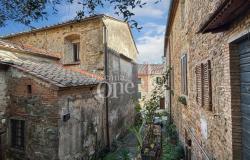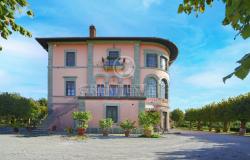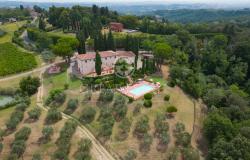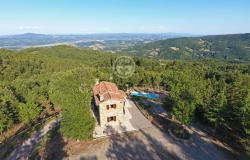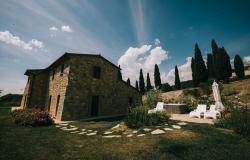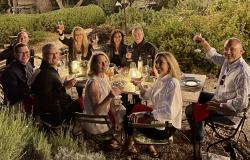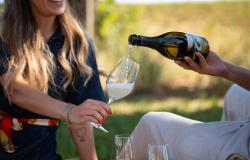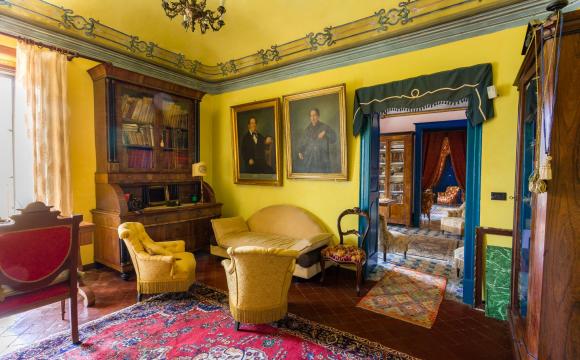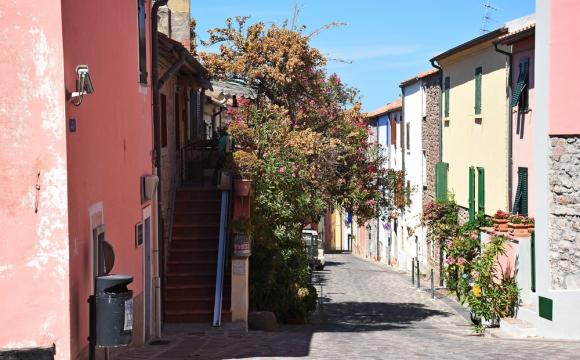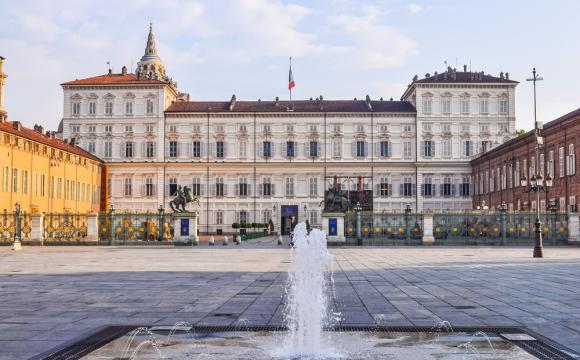In this tranquil setting varied styles of living have evolved over the years, attracting the Vincenzini family to Villa Ai Sorbi in the hills beyond Lucca, some twenty years ago. When they first saw it, it was in a sadly neglected state, having lain abandoned for more than two centuries.
Villa Ai Sorbi had been one of the most important properties in the area, the official residence of the local bishop, built above another grand villa, Villa Camigliano, a Baroque masterpiece of some splendour. Certainly the magnificent view out over the valley,
unfolding from Lucca to Pisa, still reflected the commanding position of the once elegant and imposing villa.
 And the group of buildings themselves still held the promise of grandeur, hinting at the days when the villa, guest house, chapel and church formed the centre-piece of a highly productive working farm. The land, which stretched for miles around the dilapidated buildings, was as neglected as the structures – choked with brambles, blackberries and long-ignored grapevines and olive trees.
And the group of buildings themselves still held the promise of grandeur, hinting at the days when the villa, guest house, chapel and church formed the centre-piece of a highly productive working farm. The land, which stretched for miles around the dilapidated buildings, was as neglected as the structures – choked with brambles, blackberries and long-ignored grapevines and olive trees.
Seeing the restored villa and garden today, it is hard to believe that only twenty years have passed since the family began their restoration work.
Life at Ai Sorbi revolves around the sala centrale, a typical lucchese architectural feature. It is the central room on the piano nobile, or first floor, from which the rest of the house opens out. The room is reached by a double exterior staircase, its strong formal
lines softened by pots of cascading geraniums.
Once inside you are confronted with a statue of a 16th-century gilded angel on a plinth that was bought locally. The burnished gilt of the statue, antique tables and pictures is set off to great effect by the gentle creams and pinks of the hand-painted walls.
Dining in style
 Beneath this is the formal dining room on the ground floor. Here a mixture of the original ceilings beams, one of original 14th-century rustic doors, with more formal antique painted chairs and a table laden with glass and silver are perfect for a celebration or for extended family meals.
Beneath this is the formal dining room on the ground floor. Here a mixture of the original ceilings beams, one of original 14th-century rustic doors, with more formal antique painted chairs and a table laden with glass and silver are perfect for a celebration or for extended family meals.
The dining room’s location under the main exterior staircase means that it is away from the worst of the sun. Many of the interior walls of the villa have been decorated by one of the Vincenzini daughters, Ilaria.
It was at Ai Sorbi that she first began to experiment in the art of mural decoration, from where it developed into a fully-fledged career. For the portals in the main living room, Ilaria chose the most delicate shades of grey to achieve a marbleized effect, which stands out from the pale peach-coloured walls executed in glazed stucco.
Even the floor is painted in mosaic pattern, recapturing an 18th-century Venetian tradition. Elsewhere in the villa, Ilaria has come up with unusual and effective solutions for enhancing the simple, historic character of the house, framing some of the windows in the bedrooms with classical swags and architectural frames that train the eye on the view and avoid the need for curtains.
Just as much effort went into restoring the grounds. The garden stretching up the hill behind the house, which included the ruins of a Roman-style 17th-century nymphaeum, was completely overgrown when work began. Today a pair of Tuscan terracotta figures stand guard over the rebuilt staircase leading up to the grotto. Old roses, jasmine and wisteria scent the air in this Baroque corner of the garden.
Lunches all'aperto
 The area adjacent to the newly-built swimming pool is completely different in design and is almost tropical in its luxurious overplanting.
The area adjacent to the newly-built swimming pool is completely different in design and is almost tropical in its luxurious overplanting.
Bougainvilleas and geraniums provide bold splashes of colour, framing the breathtaking view from the terrace. The new terrace is made from handmade bricks whilst palms and flowering shrubs give the setting an exotic feel. It is a marvellous location for summer lunches, when the table is set with ceramic plates from Vietri and cobalt blue glasses.
In other parts of the garden nature has been allowed to remain, providing exciting walks and a sense of mystery and discovery in counterbalance to the formal and informal planting elsewhere – this is where the wild boar still roam!
Villa Ai Sorbi is a perfect example of a modern interpretation of the aesthetics of Tuscan architecture, where antiques mingle with the modern comforts of swimming pools and heating, with a value for the good things in life above all else.
This is true to the tradition of the country residences of Tuscany, regardless of architectural style, all conceived with the simple pleasures of rural life in mind: the views of the gentle hills terraced with vineyards or orchards, the vistas of winding lanes lined with tall cypress trees and the farming traditions that mark the passing of the seasons.
Work on a much-loved family home like this one – teeming with children, grandchildren and a seemingly never-ending stream of guests – will never end and improvements are constantly being considered. Whether or not the currently disused chapel will ever cease to be the home for out-of-use garden furniture and lawnmowers is doubtful, however!


